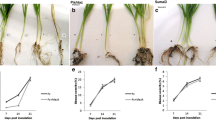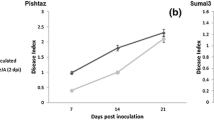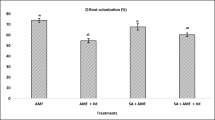Abstract
Abscisic acid (ABA) and salicylic acid (SA) alone and in combination was supplied to 4-day old seedlings of two rice cultivars Punjab Mehak 1 (resistant) and Pusa 1121 (susceptible) with and without Fusarium fujikuroi. Data was collected at 24, 48 and 72 h after treatment in shoot and root. Punjab Mehak 1 was found more sensitive to ABA and SA than Pusa 1121 during seedlings growth. It maintained higher root growth and protein content under pathogen infection than Pusa 1121. While in Pusa 1121, these were improved by application of ABA and ABA + SA. Punjab Mehak 1 showed early and high increase of lignin in roots under pathogen infection while in Pusa 1121, lignin was largely decreased. Pb. Mehak 1 showed upregulation of all three components lignin, flavonoids and phenolics under pathogen infection while Pusa 1121 showed upregulation of phenolics by decreasing lignin or flavonoids during infection. In control seedlings, exogenous applications of both ABA and SA produced almost similar effects, so might be involving common secondary signals. Response of combined ABA + SA was unique and different from single treatments.




Similar content being viewed by others
References
Agati G, Azzarello E, Pollastri S, Tattini M (2012) Flavonoids as antioxidants in plants: location and functional significance. Plant Sci 196:67–76
Asselbergh B, Achuo AE, Hofte M, Van Gijsegem F (2008a) Abscisic acid deficiency leads to rapid activation of tomato defence responses upon infection with Erwinia chrysanthemi. Mol Plant Pathol 9:11–24
Asselbergh B, De Vleesschauwer D, Hofte M (2008b) Global switches and fine tuning-ABA modulates plant pathogen defense. Mol Plant Microbe Interact 21:709–719
Atkinson NJ, Urwin PE (2012) The interaction of plant biotic and abiotic stresses: from genes to field. J Exp Bot 63:3523–3543
Badri DV, Loyola-Vargas VM, Du J, Stermitz FR, Broeckling CD, Iglesias-Andreau L, Vivanco JM (2008) Transcriptome analysis of Arabidopsis roots treated with signaling compounds: a focus on signal transduction, metabolic regulation and secretion. New Phytol 179:209–223
Carter LL, Leslie JF, Webster RK (2008) Population structure of Fusarium fujikuroi from California rice and water grass. Phytopathology 98:992–998
Chatterjee M, Gupta S, Bhar A, Chakraborti D, Basu D, Das S (2014) Analysis of root proteome unravels differential molecular responses during compatible and incompatible interaction between chickpea (Cicer arietinum L.) and Fusarium oxysporum f. sp. ciceri Race1 (Foc1). BMC Genom 15:949
Cheng WH, Endo A, Zhou L, Penney J, Chen HC, Arroyo A, Leon P, Nambara E, Asami T, Seo M, Koshiba T, Sheen J (2002) A unique short-chain dehydrogenase/reductase in Arabidopsis glucose signaling and abscisic acid biosynthesis and functions. Plant Cell 14:2723–2743
Ghasemzadeh A, Jaafar HZE (2012) Effect of salicylic acid application on biochemical changes in ginger (Zingiber officinale Roscoe). J Med Plant Res 6:790–795
Gondor OK, Janda T, Soós V, Pál M, Majláth I, Adak MK, Balázs E, Szalai G (2016) Salicylic acid induction of flavonoid biosynthesis pathways in wheat varies by treatment. Front Plant Sci 7:1447
Hura T, Hura K, Grzesiak S (2009) Possible contribution of cell-wall-bound ferulic acid in drought resistance and recovery in triticale seedlings. J Plant Physiol 166:1720–1733
Ibrahim MH, Jaafar HZ (2013) Abscisic acid induced changes in production of primary and secondary metabolites, photosynthetic capacity, antioxidant capability, antioxidant enzymes and lipoxygenase inhibitory activity of Orthosiphon stamineus Benth. Molecules 18:7957–7976
Ji Z, Zeng Y, Liang Y, Qian Q, Yang C (2016) Transcriptomic dissection of the rice–Fusarium fujikuroi interaction by RNA-seq. Euphytica 211:123–137
Kaur L, Zhawar VK (2015) Phenolic parameters under exogenous ABA, water stress, salt stress in two wheat cultivars varying in drought tolerance. Indian J Plant Physiol 20:151–156
Kaur R, Zhawar VK (2017) Hydrogen peroxide and nitric oxide regulation of phenolic metabolism under water stress and ABA in wheat. Acta Biol Hung 68:162–174
Kaur L, Gupta AK, Zhawar VK (2014a) ABA improvement of antioxidant metabolism under water stress in two wheat cultivars contrasting in drought tolerance. Indian J Plant Physiol 19:189–196
Kaur M, Gupta AK, Zhawar VK (2014b) Antioxidant response and lea genes expression under exogenous ABA and water deficit stress in wheat cultivars contrasting in drought tolerance. J Plant Biochem Biotechnol 23:18–30
Khan MIR, Fatma M, Per TS, Anjum NA, Khan NA (2015) Salicylic acid-induced abiotic stress tolerance and underlying mechanisms in plants. Front Plant Sci 6:462
Kissoudis C, van de Wiel C, Visser RGF, van der Linden G (2014) Enhancing crop resilence to combined abiotic and biotic stress through the dissection of physiological and molecular crosstalk. Front Plant Sci 5:e207
Kovácik J, Klejdus B, Hedbavny J, Backor M (2009) Salicylic acid alleviates NaCl-induced changes in the metabolism of Matricaria chamomilla plants. Ecotoxicology 18:544–554
Lee BR, Kim KY, Jung WJ, Avice JC, Ourry A, Kim TH (2007) Peroxidases and lignification in relation to the intensity of water-deficit stress in white clover (Trifoliumrepens L.). J Exp Bot 58:1271–1279
Lee S, Kim S-G, Park C-M (2010) Salicylic acid promotes seed germination under high salinity by modulating antioxidant activity in Arabidopsis. New Phytol 188:626–637
Ma L, Ji Z, Bao J, Zhu X, Li X, Zhuang J, Yang C, Xia Y (2008) Responses of rice genotypes carrying different dwarf genes to Fusarium moniliforme and gibberellic acid. Plant Prod Sci 11:134–138
Matić S, Bagnaresi P, Biselli C, Orru’ L, Carneiro GA, Ilenia Siciliano I, Valé G, Gullino ML, Spadaro D (2016) Comparative transcriptome profiling of resistant and susceptible rice genotypes in response to the seed borne pathogen Fusarium fujikuroi. BMC Genom 17:608
Miller G, Suzuki N, Ciftci-Yilmaz S, Mittler R (2010) Reactive oxygen species homeostasis and signalling during drought and salinity stresses. Plant Cell Environ 33(4):453–467
Mittler R (2006) Abiotic stress, the field environment and stress combination. Trends Plant Sci 11:15–19
Moura JC, Bonine CA, de Oliveira FernandesViana J, Dornelas MC, Mazzafera P (2010) Abiotic and biotic stresses and changes in the lignin content and composition in plants. J Integr Plant Biol 52:360–376
Naghavi F (2016) Reviews of salicylic acid mist spray on amount of flavonoids, anthocyanins, sugar and root performance at marigold flower species (Calendula officinalis L) at hydroponics system. Int J Adv Biotechnol Res 7:464–471
Nishimura N, Okamoto M, Narusaka M, Yasuda M, Nakashita H, Shinozaki K, Narusaka Y, Hirayama T (2009) ABA hypersensitive germination2-1 causes the activation of both abscisic acid and salicylic acid responses in Arabidopsis. Plant Cell Physiol 50:2112–2122
Rasmussen S, Barah P, Suarez-Rodriguez MC, Bressendorff S, Friis P, Costantino P, Bones AM, Nielsen HB, Mundy J (2013) Transcriptome responses to combinations of stresses in Arabidopsis. Plant Physiol 161:1783–1794
Rosa M, Prado C, Podazza G, Interdonato R, Gonzalez JA, Hilal M, Prado FE (2009) Soluble sugars—metabolism, sensing and abiotic stress. Plant Signal Behav 4:388–393
Siciliano I, Amaral Carneiro G, Spadaro D, Garibaldi A, Gullino ML (2015) Jasmonic acid, abscisic acid, and salicylic acid are involved in the phytoalexin responses of rice to Fusarium fujikuroi, a high gibberellin producer pathogen. J Agric Food Chem 63:8134–8142
Song W, Maa X, Tan H, Zhou J (2011) Abscisic acid enhances resistance to Alternaria solani in tomato seedlings. Plant Physiol Biochem 49:693–700
Taheri P, Kakooee T (2017) Reactive oxygen species accumulation and homeostasis are involved in plant immunity to an opportunistic fungal pathogen. J Plant Physiol 216:152–163
Ton J, Mauch-Mani B (2004) β-amino-butyric acid-induced resistance against necrotrophic pathogens is based on ABA-dependent priming for callose. Plant J 38:119–130
Ton J, Flors V, Mauch-Mani B (2009) The multifaceted role of ABA in disease resistance. Trends Plant Sci 14:310–317
Wiese J, Kranz T, Schubert S (2004) Induction of pathogen resistance in barley by abiotic stress. Plant Biol 6:529–536
Xue YJ, Tao L, Yang ZM (2008) Aluminum-induced cell wall peroxidase activity and lignin synthesis are differentially regulated by jasmonate and nitric oxide. J Agric Food Chem 56:9676–9684
Zehra A, Meena M, Dubey MK, Aamir M, Upadhyay RS (2017) Synergistic effects of plant defense elicitors and Trichoderma harzianum on enhanced induction of antioxidant defense system in tomato against Fusarium wilt disease. Bot Stud 58:44
Zhang J, Jia W, Yang J, Ismail AM (2006) Role of ABA in integrating plant responses to drought and salt stresses. Field Crops Res 97:111–119
Author information
Authors and Affiliations
Corresponding author
Ethics declarations
Conflict of interest
Authors declare that they have no conflict of interest, they have informed consent and this research did not involve human and/or animals participants.
Additional information
Publisher's Note
Springer Nature remains neutral with regard to jurisdictional claims in published maps and institutional affiliations.
Rights and permissions
About this article
Cite this article
Kaur, A., Zhawar, V.K., Pannu, P.P.S. et al. Effect of abscisic acid and salicylic acid on growth and phenolic parameters under Fusarium fujikuroi infection in rice seedlings. Indian Phytopathology 72, 253–260 (2019). https://doi.org/10.1007/s42360-019-00142-9
Received:
Revised:
Accepted:
Published:
Issue Date:
DOI: https://doi.org/10.1007/s42360-019-00142-9




